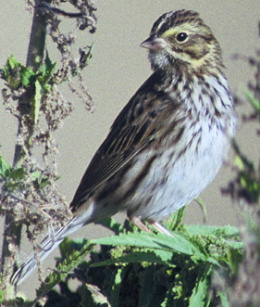Savannah Sparrow
|
|
| Savannah Sparrow | ||||||||||||||
|---|---|---|---|---|---|---|---|---|---|---|---|---|---|---|
 | ||||||||||||||
| Scientific classification | ||||||||||||||
| ||||||||||||||
| Binomial name | ||||||||||||||
| Passerculus sandwichensis (Gmelin,, 1789) |
The Savannah Sparrow, Passerculus sandwichensis, is a small sparrow. It is the only member of the genus Passerculus (Bonaparte, 1838).
This passerine bird breeds in Alaska, Canada, northern, central and Pacific coastal USA, Mexico and Guatemala. The Pacific and Mexican breeders are resident, but other populations are migratory, wintering from the southern United States to northern South America. It is a very rare vagrant to western Europe.
Savannah Sparrow is a very variable species, with numerous races, several of which have been split as separate species at various times. The different forms vary principally in the darkness of the plumage, with Alaskan and interior races the palest, and southern Pacific coastal forms the darkest.
This species has a typically sparrow-like dark-streaked brown back, and whitish underparts with brown or blackish breast and flank streaking. It has yellowish or whitish crown and eyebrow stripes. The cheeks are brown and the throat white.
The breeding habitat is a wide variety of open habitats including grasslands and cultivation. Savannah Sparrows nest on the ground, laying 3-6 eggs in a cup nest sheltered by a clump of grass or other vegetation.
These birds forage on the ground or in low bushes. They mainly eat seeds, but insects are also eaten in the breeding season. They form flocks on migration or in winter.
The song is mixture of chips and trills. The flight call is a thin seep.
This bird was named after Savannah, Georgia where one of the first specimens of this bird was collected.
Although this bird is generally abundant across its range, some coastal populations depending on salt marsh habitat are declining.
Subspecies
The Ipswich Sparrow, P. s. princeps, breeds almost exclusively on Sable Island. At one time considered to be a separate species, this bird is somewhat larger and paler in colour than other eastern Savannah Sparrows. The breast streaks are narrower and pale brown. Some birds overwinter on the island; others migrate south along the Atlantic coast, usually departing later and returning sooner than mainland birds. Some birds interbreed with P. s. savanna in Nova Scotia. These birds frequently raise three broods in a year. This bird was first observed in winter on the dunes near the town of Ipswich, Massachusetts.
Reference
Buntings and Sparrows by Byers, Olsson and Curson, ISBN 0-7470-3202-5
External Link
- Species at risk - Ipswich Sparrow (http://www.speciesatrisk.gc.ca/search/speciesDetails_e.cfm?SpeciesID=49)
